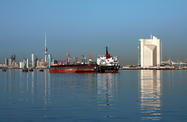Kuwait’s ambition to become a leading trading centre for the region took a step forward earlier this month, when the foundation stone for the new Mubarak Al Kabir port was laid, at a ceremony attended by Emir Sheikh Sabah Al Ahmed Al Jaber Al Sabah.
Situated on the 530-sq-km Boubyan Island in the Gulf, close to the Iraqi port town of Umm Qasr, the new container port will significantly boost the country’s handling capacity, adding 60 berths by 2033 and an expected volume of 1.8m containers per year by 2015.
Developed in five stages, the port superstructure is expected to cost KD40m ($144.5m), while the wider infrastructural developments for the island could total as much as KD305m ($1.1bn). While these plans have been on paper for some time, the commencement of actual construction, by the Korean contracting firm, Hyundai, should build confidence in the government’s ability to deliver on these ambitious plans.
These developments would help reposition Kuwait’s standing in the region and enable it to better compete with other ports in the area. Kuwait is well placed to grow its cargo traffic. Situated at the head of the Arabian Gulf, the country provides a perfect entry point to the growing Iraqi market and a useful transit corridor to the rest of the peninsula.
The government, therefore, hopes to build on this demand. The forecasts largely support this optimism. According to market research by Business Monitor International, Kuwait’s two main ports, Shuaiba and Shuwaikh, are both expected to experience growth in 2011. The former is expected to post growth of 3.44%, with a total throughput of 20.55m tonnes, while the latter should see traffic grow by 2.93% to a total of 9.33m tonnes this year. However, both ports are still struggling to reach their pre-downturn handling levels, with Shuaiba not forecast to hit these heights again until 2013.
To truly reach its target of becoming a logistics hub for the entire region, the country will have to work on a number of other measures to attract traffic. One of the most pressing measures will be expediting the process of moving goods through the country’s various ports. This will be as much about the procedural environment as about the infrastructural capacity.
According to the World Bank’s “Doing Business 2011” report, Kuwait ranked 113th, out of 183 economies for trading across borders. As the report highlights, it remains costly and time-consuming to shuttle goods through the emirate’s ports. It currently takes 17 days, at a cost of $1060, to export a container through Kuwait’s ports. For imports, the figures are 19 days at a cost of $1217. Indeed, the country scores poorly compared to others in the region, ranking a full 80 places lower than Bahrain and 95 places lower than its neighbour, Saudi Arabia.
If the government can address this issue, it may see its exports and re-exports inch steadily northwards, from the 2010 figures of KD1.24bn ($4.5bn) and KD512m ($1.9bn), according to the Central Bank of Kuwait. While much still needs to be done to bolster these figures, the Mubarak Al Kabir Port is a good start, not only because it will boost the country’s port capacity, but also because of the signal of intent it sends for wider infrastructural development.
Indeed, Boubyan is simply one part of a much larger spending plan to dramatically improve the transport network in the country. The national development plan, approved by the parliament in February 2010, has earmarked $108bn to help diversify the Kuwaiti economy, with spending targeted in areas such as health care, housing and transport. This should provide a timely boost to plans for the upgrade and overhaul of the country’s road and rail networks. However, the most important project that falls under the plan is the expansion of Kuwait’s International Airport. Currently, in the design phase, the project hopes to boost capacity from 7m passengers a year to more than 20m. The new 13m-passenger terminal is expected to be completed by 2016 with the cost estimated to be between KD350m ($1.3bn) and KD500m ($1.8bn).
There has, however, been some scepticism over the ability of Kuwait to deliver on these plans. While the national development plan has been welcomed, caution remains the prevailing sentiment. As such, the breaking of ground on Mubarak Al Kabir was a significant moment for the country. Kuwait has always had the funds and the demand dynamics to meet its ambition of becoming a regional trading centre. What the ceremony in April tells us is that this might now be matched by the required intent.

